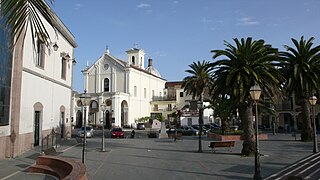See also
- List of members of the Camorra
- List of Camorra clans
- Antonio La Torre
- Augusto La Torre
- Camorra
- List of most wanted fugitives in Italy
The Pescopagano massacre (Italian:Strage di Pescopagano) was a massacre perpetrated by the La Torre clan on 24 April 1990 in front of a bar in Pescopagano, in the municipality of Mondragone, located in the province of Caserta, Italy.
The massacre resulted in the accidental deaths of five people, that included three Tanzanians, an Iranian, and an Italian. In addition to this, seven people were injured, including the bar manager and his fourteen-year-old son, who became paralyzed after suffering from a broken vertebra. The bloodbath was the result of an internal conflict between the native Camorra, the La Torre clan that had run and controlled the whole municipality and its rackets for years and the new Tanzanian and Ghanaian immigrants, under a new drug cartel that operated from Middle Eastern countries and Africa and planned to act in Italy. [1]
In October 2019, Augusto La Torre, former head of the La Torre clan was sentenced to life imprisonment. He was found guilty of being the instigator and executor of the Pescopagano massacre. According to the investigations reconstruction, the massacre happened because La Torre wanted to "clean up" the Pescopagano area from African drug dealers. [2]
The Camorra is an Italian Mafia-type criminal organization and criminal society originating in the region of Campania. It is one of the oldest and largest criminal organizations in Italy, dating to the 17th century. Unlike the pyramidal structure of the Sicilian Mafia, the Camorra's organizational structure is divided into individual groups also called "clans". Every capo or "boss" is the head of a clan, in which there may be tens or hundreds of affiliates, depending on the clan's power and structure. Consequently, as Camorra clans act independently, they are more prone to feuding among themselves. The Camorra's main businesses are drug trafficking, racketeering, counterfeiting and money laundering. It is also not unusual for Camorra clans to infiltrate the politics of their respective areas.
Sacra Corona Unita also known as fourth mafia is a Mafia-type criminal organization and criminal society from the Apulia region in Southern Italy, and it is especially active in the areas of Brindisi, Lecce, and Taranto.

Organized crime in Italy and its criminal organizations have been prevalent in Italy, especially Southern Italy, for centuries and have affected the social and economic life of many Italian regions since at least the 19th century.

Castel Volturno is a comune (municipality) in the Province of Caserta in the Italian region Campania, located about 35 kilometres (22 mi) northwest of Naples and about 35 kilometres (22 mi) west of Caserta on the Volturno river. In 2010 Castel Volturno was inhabited by 25,000 locals and about 18,000 African refugees. Today (2019) there are still about 25,000 people, estimated two-thirds of them are immigrants.

Paolo Di Lauro is an Italian crime boss, leader of the Di Lauro Clan, a Camorra crime organization. He is also known as Ciruzzo 'o milionario among other aliases. In 2002 he was included in the list of most wanted fugitives in Italy and was captured in September 2005.
The Di Lauro clan is an Italian crime clan, part of the Camorra in Naples. The clan operates in the neighbourhoods of Secondigliano, Scampìa, Miano, Marianella, Piscinola, and in the adjacent municipalities of Casavatore, Melito, Arzano, Villaricca and Mugnano. At its peak, between the mid-1990s and the early 2000s, the organization was earning more than €500,000 a day from the sale of drugs alone, making Secondigliano the largest open-air drug market in Europe. The founder of the clan is Paolo Di Lauro, from Via Cupa dell'Arco, in Secondigliano.

Antonio Bardellino was a powerful Neapolitan Camorrista and boss of the Casalesi clan, having a prominent role in the organized crime in the province of Caserta during the 1980s. He was one of the last of the old-style Camorra godfathers.
The Lo Russo clan was a Neapolitan Camorra clan operating on its territory within the city of Naples, concentrated specifically in the area of Miano, whose control extended throughout numerous neighborhoods in the north of the city for more than three decades. Since the fall of all the Lo Russo brothers, and the numerous arrests of most of its affiliates, the organization is considered overthrown.

The Nuvoletta clan was a powerful Neapolitan Camorra clan operating from the town of Marano di Napoli, situated on the northern outskirts of the city of Naples, southern Italy. The Nuvolettas belonged to a new style of Camorra, one that had the dimensions of a large corporation, and considered much more entrepreneurial. The clan was affiliated with several Sicilian Mafia families and was considered one of the most powerful Camorra clans between the 1970s and 1990s, however, since the death of its historical leaders and the large number of arrests and seizures made by the Italian police, the clan was succeeded by the Polverino and Orlando clans, both families with great degree of kinship with the Nuvoletta family.
The Castel Volturno massacre is the name given by the Italian press to a mass shooting perpetrated by the Casalesi clan in which seven people were killed on 18 September 2008. The massacre outside the Ob Ob Exotic Fashion tailor shop on the Via Domitiana was widely characterized as part of a growing conflict between the native Camorra and the immigrant African drug gangs. Murdered were Antonio Celiento, the owner of an arcade next to Baia Verde, and six African immigrants: Samuel Kwaku, 26 (Togo); Alaj Ababa (Togo); Francis Antwi, 31 (Ghana); Eric Affum Yeboah, 25 (Ghana); Alex Geemes, 28 (Liberia) and Cristopher Adams, 28 (Liberia). Joseph Ayimbora (Ghana), 34, survived by feigning death; he later helped identify the killers. None of the African victims were involved in criminal activities and were chosen at random.

Augusto La Torre is an Italian criminal and former Camorra boss. Up until his arrest and subsequent collaboration with Italian justice in January 2003, La Torre was the head of the now defunct La Torre clan, a powerful Camorra organization whose vast lucrative criminal empire stretched from its base Mondragone in the hinterland of Campania out into Aberdeen, Scotland, as well as the Netherlands.

Antonio La Torre is an Italian multi-billionaire real estate developer, restaurateur and member of the Camorra. He is the brother of Augusto La Torre, the former head of the powerful La Torre clan from Mondragone. In 1984 he moved to Aberdeen in Scotland with his Scottish wife, Gillian F Strang, evading the authorities in Italy. Until his arrest and subsequent extradition to Italy in March 2005, he was in charge of the clan's local branch in Aberdeen, Scotland, where he managed the clan's day-to-day activities and businesses. La Torre ran eight Italian restaurants in Scotland and a currently owns two real estate agencies based in London.
Cosimo Di Lauro is an Italian Camorrista and former acting boss of the Di Lauro clan from Naples. Due to his flamboyant nature and passion for designer clothes, he earned the nickname "The Designer Don". Di Lauro is known by some as "o' Chiatto", and to journalists as the "prince regent".

Marco Di Lauro is an Italian Camorrista and member of the Di Lauro clan from Naples. After having been a fugitive for 14 years and been included on the list of most wanted fugitives in Italy, he was captured in Naples on 2 March 2019.
The Train 904 bombing was a terror attack which occurred on 23 December 1984, in the Apennine Base Tunnel. A bomb on the 904 express train from Naples to Milan was detonated, killing 16 and wounding 266. The bombing location was near the location of the Italicus Express bombing ten years previously.
The Secondigliano Alliance is a strategic alliance of Camorra clans in Naples, Italy and its hinterland which controls drug trafficking and the extortion racket in many areas of Naples since the 1990s. The Alliance has branches in the Netherlands and in Spain, with interests in international drug trafficking and massive money laundering.
The De Luca Bossa clan is a Neapolitan Camorra clan operating in the eastern suburbs of Naples, and more specifically in the area of Ponticelli and in municipality of Cercola.
The Mazzarella clan is a Campanian Camorra clan operating in the city of Naples. The clan is historically considered one of the most powerful groups of the Camorra.
The Polverino clan is a Neapolitan Camorra clan operating in the town of Marano di Napoli. The clan is present also in Villaricca, Quarto, Pozzuoli, Qualiano and in the district Camaldoli of Naples. Outside Italy, the clan has a strong presence in Spain, in particular in Barcelona, Málaga and Alicante. According to the investigations, the Polverinos are considered the successors of the Nuvoletta clan.
The Società foggiana, also known as Mafia Foggiana and the fifth mafia, is a mafia-type Italian organized criminal organization and criminal society operating in a large part of the Province of Foggia, including the city of Foggia itself, and having significant infiltrations also in other Italian regions. Currently, it is considered one of the most brutal and bloody of all the organized crime groups in Italy—there was about one murder a week, one robbery a day and an extortion attempt every 48 hours in Foggia province in 2017 and 2018. These were wrongly reported as the work of the Sacra Corona Unita by news media unaware of the new independent mafia in Foggia province. "But that wasn't the case. We are witnessing what should be called a fifth mafia, independent of the Sacra Corona Unita", according to Giuseppe Volpe, a prosecutor and anti-mafia head of Bari.